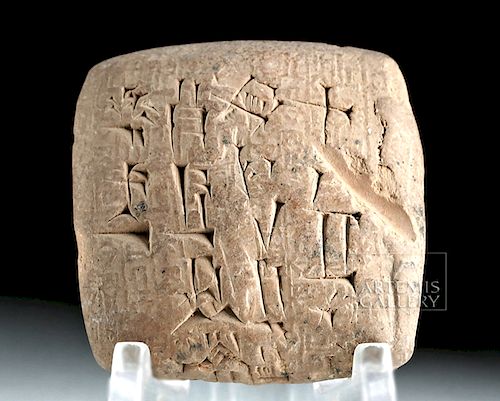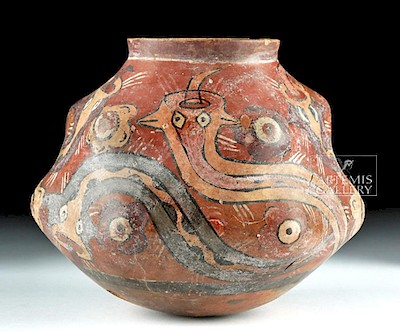Sumerian Cuneiform Ceramic Tablet
Lot 76
About Seller
Artemis Gallery
686 S Taylor Ave, Ste 106
Louisville, CO 80027
United States
Selling antiquities, ancient and ethnographic art online since 1993, Artemis Gallery specializes in Classical Antiquities (Egyptian, Greek, Roman, Near Eastern), Asian, Pre-Columbian, African / Tribal / Oceanographic art. Our extensive inventory includes pottery, stone, metal, wood, glass and textil...Read more
Categories
Estimate:
$600 - $900
Absentee vs Live bid
Two ways to bid:
- Leave a max absentee bid and the platform will bid on your behalf up to your maximum bid during the live auction.
- Bid live during the auction and your bids will be submitted real-time to the auctioneer.
Bid Increments
| Price | Bid Increment |
|---|---|
| $0 | $25 |
| $300 | $50 |
| $1,000 | $100 |
| $2,000 | $250 |
| $5,000 | $500 |
| $10,000 | $1,000 |
| $20,000 | $2,500 |
| $50,000 | $5,000 |
| $100,000 | $10,000 |
| $200,000 | $20,000 |
About Auction
By Artemis Gallery
Jul 5, 2018
Set Reminder
2018-07-05 10:00:00
2018-07-05 10:00:00
America/New_York
Bidsquare
Bidsquare : Ancient | Ethnographic | Fine Art
https://www.bidsquare.com/auctions/artemis-gallery/ancient-ethnographic-fine-art-3306
Featuring classical antiquities, ancient and ethnographic art from cultures encompassing the globe. Artemis Gallery info@artemisgallery.com
Featuring classical antiquities, ancient and ethnographic art from cultures encompassing the globe. Artemis Gallery info@artemisgallery.com
- Lot Description
Ancient Near East, Sumeria, ca. 3rd to 2nd millennium BCE. A round-edged, square "biscuit" or tablet with both sides incised with cuneiform. Cuneiform script is one of the oldest known writing systems in the world, made using a reed as a stylus and scratching wedge-shaped marks onto clay tablets. Early cuneiform was pictographic, but in the 3rd millennium BCE it shifted to the more abstract form you see here. Size: 1.45" W (3.7 cm)
This cuneiform tablet is one of the roughly 2 million known from this culture; of these, between 30,000 and 100,000 have been translated. The earliest translations came in 1836 from the work of French scholar Eugene Burnouf and by the 1850s multiple scholars were able to produce similar translations, meaning the language had been deciphered. Similar to many other known cuneiform tablets, this one is concerned with property. Cuneiform tablets seem to have been used mainly as a way of tabulating economic concerns. Although it might be more romantic to imagine that these tablets discussed the doings of kings and gods, from a historical standpoint, it is much more interesting to learn about the daily transactions of humanity's first great urban center.
Provenance: private Davis collection, Houston, Texas, USA; ex-Joseph Klein collection, formed in New York, New York, USA between 1941 and 1980, thence by descent
All items legal to buy/sell under U.S. Statute covering cultural patrimony Code 2600, CHAPTER 14, and are guaranteed to be as described or your money back.
A Certificate of Authenticity will accompany all winning bids.
We ship worldwide and handle all shipping in-house for your convenience.
#132824Intact. Not translated but could be, with very clear characters.Condition
- Shipping Info
-
All shipping is handled in-house for your convenience. Your invoice from Artemis Gallery will include shipping calculation instructions. If in doubt, please inquire BEFORE bidding for estimated shipping costs for individual items.
-
- Buyer's Premium



 EUR
EUR CAD
CAD AUD
AUD GBP
GBP MXN
MXN HKD
HKD CNY
CNY MYR
MYR SEK
SEK SGD
SGD CHF
CHF THB
THB















